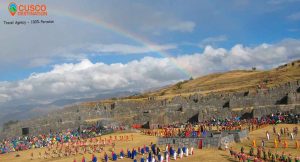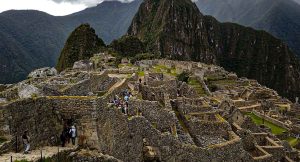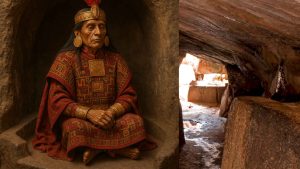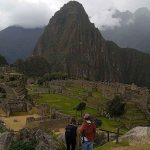Wayna Picchu, also known as Huayna Picchu, is the iconic mountain that rises behind the Inca citadel of Machu Picchu in Peru. Its name in Quechua means “young mountain,” and its height reaches 2,720 meters above sea level. This majestic peak not only provides a stunning backdrop but also an exciting destination for adventurers seeking a unique experience.

Summary
Key Features:
– Location and Access: Wayna Picchu is located within the Machu Picchu archaeological complex. To ascend, you need a special ticket that must be booked in advance due to high demand.
– The Ascent: The hike to the summit is challenging, with steep trails and the famous “Stairs of Death.” However, the effort is worth it, as it offers spectacular panoramic views of the citadel and the Urubamba River valley.
– History and Archaeology: Along the way, you’ll encounter Inca agricultural terraces, sacred temples, and paths that reflect the mountain’s spiritual and astronomical significance to the Incas.
– Practical Tips: It’s essential to wear comfortable clothing, appropriate footwear, water, and a camera to capture the unique views from the summit.
Wayna Picchu combines history, adventure, and nature into an unforgettable experience. Would you dare to conquer its heights?
Recent Discoveries and Archaeological Context
In recent years, archaeological research has shed new light on the importance of Wayna Picchu within the Machu Picchu complex. According to recent studies, the mountain not only served as a strategic observation point but also housed ceremonial and agricultural structures that reflect the sophistication of Inca engineering.
Among the most notable discoveries are agricultural terraces that, in addition to optimizing the use of the mountainous terrain, served a ritual purpose. These terraces are connected by cobblestone paths leading to temples and viewpoints, suggesting that Wayna Picchu was a sacred and functional space.
New Insights into Its Name
A recent study has suggested that the original name of the Inca citadel could have been “Huayna Picchu” instead of “Machu Picchu.” This discovery is based on historical documents from the 16th century and the notes of explorer Hiram Bingham, who rediscovered the site in 1911. This shift in perspective underscores the importance of Wayna Picchu not only as a mountain, but as a central element in the identity of the archaeological complex.
Visitor Experience
The climb to Wayna Picchu is a unique but challenging experience. The trails are steep and narrow, with sections known as the “stairs of death.” However, the reward is unmatched: panoramic views of the Machu Picchu citadel, the Urubamba River, and the surrounding mountains.
Conservation and Current Challenges
Recent research has also highlighted the need to conserve this heritage. Increased tourism and climate change pose significant challenges to the preservation of Wayna Picchu. Therefore, authorities have implemented measures such as limiting the number of daily visitors and restoring damaged structures.
Wayna Picchu remains a symbol of Inca grandeur and a testament to their connection with nature and spirituality.

https://es.wikipedia.org/wiki/Huayna_Picchu
Wayna Picchu is a fascinating site from an archaeological perspective. Some of the highlights include:
– Agricultural terraces: These structures not only optimized the use of the mountainous terrain but also served a ritual purpose. They reflect the Inca’s ability to integrate agriculture with spirituality.
– Temple of the Moon: Located on the backside of the mountain, this temple is a masterpiece of Inca architecture. It is believed to have had ceremonial and astronomical functions.
– Cobblestone paths: The paths connecting the terraces and temples are a testament to the Inca’s advanced engineering. These paths are designed to withstand the test of time and weather conditions.
– Strategic viewpoints: From the top of Wayna Picchu, the Incas could observe the entire citadel of Machu Picchu and the Urubamba River valley. This suggests that the mountain also served a defensive purpose.
These elements make Wayna Picchu a unique site that combines history, engineering, and spirituality.

Visiting Wayna Picchu can be an unforgettable experience, but due to its demanding nature and site regulations, it’s important to be prepared. Here are some key tips to make the most of your visit:
Previous Preparation
– Book in advance: Tickets to Wayna Picchu are limited and tend to sell out quickly. Make sure to book several months in advance.
– Recommended time: Choose the morning shift if you prefer to ascend in cooler temperatures. There are two schedules available: 7:00 to 8:00 a.m. or 10:00 to 11:00 a.m.
– Appropriate Equipment: Wear comfortable clothing and sturdy footwear, preferably hiking shoes. Also, pack a small backpack with water, sunscreen, and insect repellent.
During the Visit
– Physical and Safety: The ascent is steep, and some areas, such as the “Stairs of Death,” can be intimidating. Take it easy and use the handrails whenever possible.
– Respect the rules: Access to certain areas may be restricted to protect the heritage. Follow the guides’ instructions and signs.
– Don’t forget your camera: The views from the top of Wayna Picchu are spectacular and deserve to be captured. But be careful when using it in narrow areas to avoid accidents.

https://es.wikipedia.org/wiki/Huayna_Picchu
Additional Tips
– Light meals: Although eating along the trail is prohibited, you can bring snacks to consume outside the archaeological areas.
– Physical preparation: If you are not used to demanding hikes, consider training beforehand, especially to acclimatize to the altitude.
– Complementary visit: Take the opportunity to explore the Temple of the Moon, located on the back of the mountain. It is less well-known, but equally fascinating.
By following these tips, you can enjoy a safe and rewarding experience while discovering the magic of Wayna Picchu. It is a place worth every step!







Leave A Reply